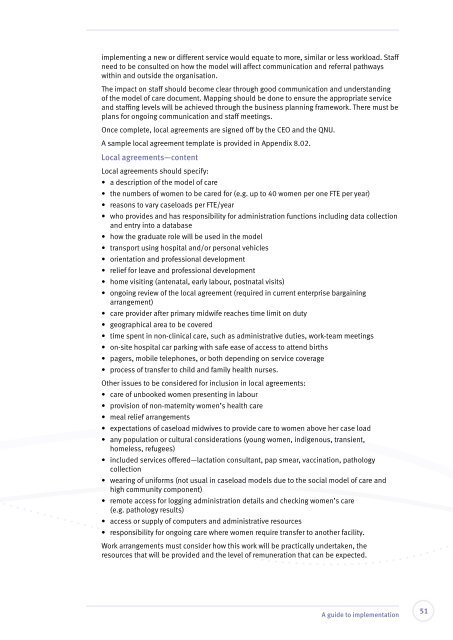Delivering continuity of midwifery care to Queensland women
Delivering continuity of midwifery care to Queensland women
Delivering continuity of midwifery care to Queensland women
You also want an ePaper? Increase the reach of your titles
YUMPU automatically turns print PDFs into web optimized ePapers that Google loves.
implementing a new or different service would equate <strong>to</strong> more, similar or less workload. Staff<br />
need <strong>to</strong> be consulted on how the model will affect communication and referral pathways<br />
within and outside the organisation.<br />
The impact on staff should become clear through good communication and understanding<br />
<strong>of</strong> the model <strong>of</strong> <strong>care</strong> document. Mapping should be done <strong>to</strong> ensure the appropriate service<br />
and staffing levels will be achieved through the business planning framework. There must be<br />
plans for ongoing communication and staff meetings.<br />
Once complete, local agreements are signed <strong>of</strong>f by the CEO and the QNU.<br />
A sample local agreement template is provided in Appendix 8.02.<br />
Local agreements—content<br />
Local agreements should specify:<br />
• a description <strong>of</strong> the model <strong>of</strong> <strong>care</strong><br />
• the numbers <strong>of</strong> <strong>women</strong> <strong>to</strong> be <strong>care</strong>d for (e.g. up <strong>to</strong> 40 <strong>women</strong> per one FTE per year)<br />
• reasons <strong>to</strong> vary caseloads per FTE/year<br />
• who provides and has responsibility for administration functions including data collection<br />
and entry in<strong>to</strong> a database<br />
• how the graduate role will be used in the model<br />
• transport using hospital and/or personal vehicles<br />
• orientation and pr<strong>of</strong>essional development<br />
• relief for leave and pr<strong>of</strong>essional development<br />
• home visiting (antenatal, early labour, postnatal visits)<br />
• ongoing review <strong>of</strong> the local agreement (required in current enterprise bargaining<br />
arrangement)<br />
• <strong>care</strong> provider after primary midwife reaches time limit on duty<br />
• geographical area <strong>to</strong> be covered<br />
• time spent in non-clinical <strong>care</strong>, such as administrative duties, work-team meetings<br />
• on-site hospital car parking with safe ease <strong>of</strong> access <strong>to</strong> attend births<br />
• pagers, mobile telephones, or both depending on service coverage<br />
• process <strong>of</strong> transfer <strong>to</strong> child and family health nurses.<br />
Other issues <strong>to</strong> be considered for inclusion in local agreements:<br />
• <strong>care</strong> <strong>of</strong> unbooked <strong>women</strong> presenting in labour<br />
• provision <strong>of</strong> non-maternity <strong>women</strong>’s health <strong>care</strong><br />
• meal relief arrangements<br />
• expectations <strong>of</strong> caseload midwives <strong>to</strong> provide <strong>care</strong> <strong>to</strong> <strong>women</strong> above her case load<br />
• any population or cultural considerations (young <strong>women</strong>, indigenous, transient,<br />
homeless, refugees)<br />
• included services <strong>of</strong>fered—lactation consultant, pap smear, vaccination, pathology<br />
collection<br />
• wearing <strong>of</strong> uniforms (not usual in caseload models due <strong>to</strong> the social model <strong>of</strong> <strong>care</strong> and<br />
high community component)<br />
• remote access for logging administration details and checking <strong>women</strong>’s <strong>care</strong><br />
(e.g. pathology results)<br />
• access or supply <strong>of</strong> computers and administrative resources<br />
• responsibility for ongoing <strong>care</strong> where <strong>women</strong> require transfer <strong>to</strong> another facility.<br />
Work arrangements must consider how this work will be practically undertaken, the<br />
resources that will be provided and the level <strong>of</strong> remuneration that can be expected.<br />
A guide <strong>to</strong> implementation<br />
51
















